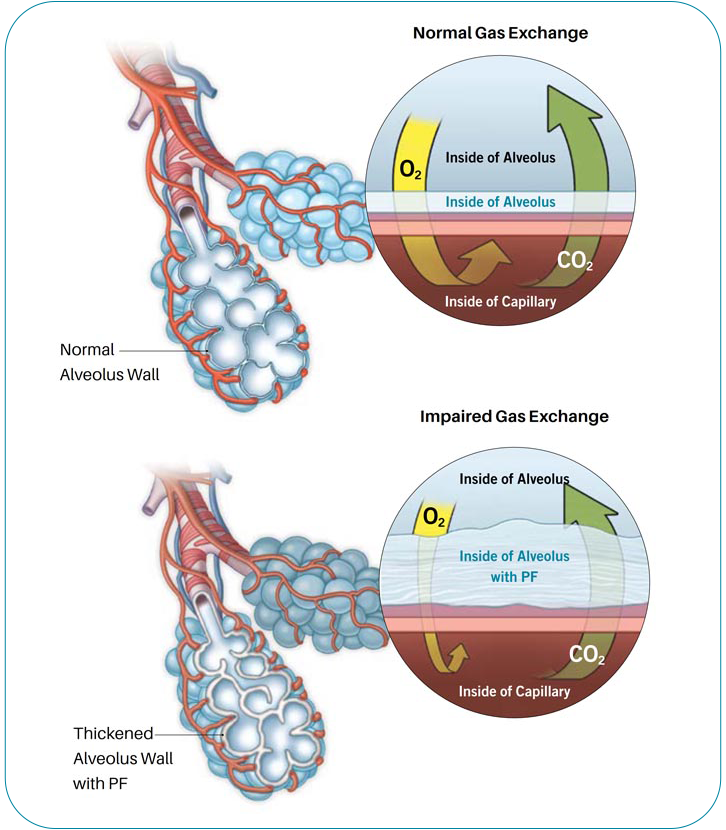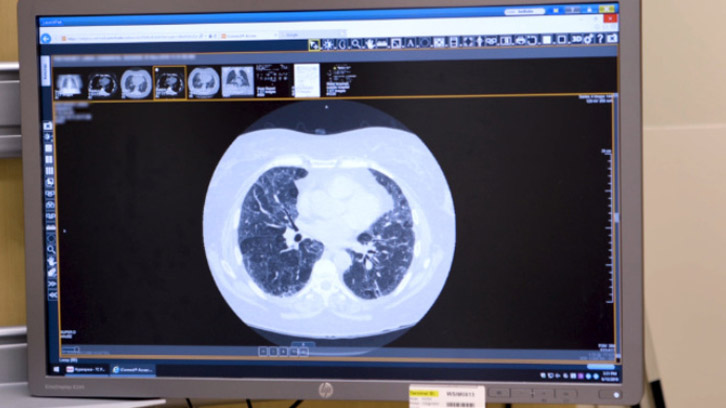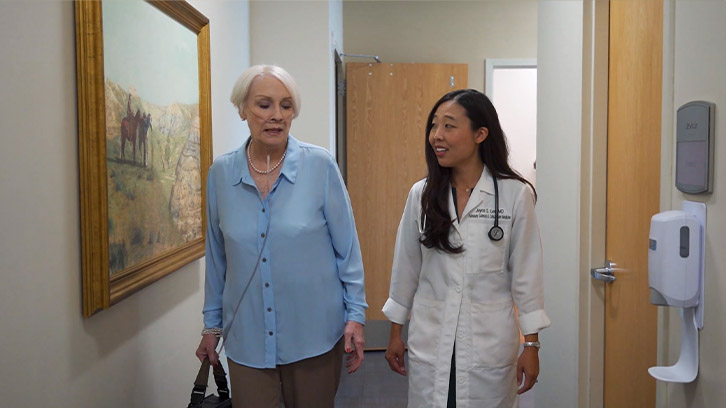Diagnosis

How Do Doctors Recognize and Diagnose Pulmonary Fibrosis?
There are three consequences of PF. Doctors use these consequences to recognize that someone has PF:
Stiff Lungs. Scar tissue and inflammation make your lungs stiff. Stiff lungs are hard to stretch, so your breathing muscles have to work extra hard just to pull air in with each breath. Your brain senses this extra work, and it lets you know there’s a problem by triggering a feeling of breathlessness (or “shortness” of breath) while exerting yourself. Also, stiff lungs hold less air (they shrink a bit). Doctors take advantage of this “shrinking” to diagnose and track the disease using breathing tests (called Pulmonary Function Tests) that measure how much air your lungs can hold. The more scar tissue your lungs have, the less air they will hold.
Low blood oxygen. Scar tissue blocks the movement of oxygen from the inside of your air sacs into your bloodstream. For many people living with pulmonary fibrosis, oxygen levels are only reduced a little bit while resting, but their oxygen levels drop quite a bit during activity. The brain can sense these low oxygen levels, triggering breathlessness. Doctors will check your oxygen levels to see if they drop after walking, which could be a clue that PF might be present. Doctors also often prescribe oxygen to be used through a nasal cannula or a facemask during activity and sleep for those with PF. As pulmonary fibrosis progresses, oxygen may be needed 24 hours a day and flow rates may increase.
“Crackles" lung sounds. Your doctor may have told you that “crackles” were heard in your lungs. Crackles (also called “rales”) sound like Velcro being pulled apart. They are heard in many lung diseases because any type of problem affecting the air sacs (such as PF, pneumonia, or a buildup of fluid in the lungs from heart failure) can cause crackles. Some people with pulmonary fibrosis don’t have crackles, but most do.Determining the Type of PF
Once your doctor recognizes that you might have pulmonary fibrosis, the next step is to try to diagnose the specific kind of PF you have— there are more than 200 different kinds. Doctors typically start by asking many questions, performing a careful physical examination, and ordering a lot of blood tests. See Causes for more information.


HRCT Scans
A doctor will use a special kind of X-ray of the chest, called a high-resolution computed tomography (HRCT) scan, so that they can see what your lung tissue looks like. HRCT scans give a close-up view of the lungs, providing more detail than routine CT scans (also known as CAT scans). Healthy lung tissue looks nearly black on a CT scan. Scar tissue and inflammation both appear gray or white. Many forms of PF look similar on a CT scan to the untrained eye, but subtle findings on HRCT scans are critically important when trying to identify which type of PF you have.
Sometimes, even after all of the testing is complete, a doctor will still not have an answer and will have to perform a lung biopsy to try to identify which of the 200 different types of pulmonary fibrosis you have. When indicated, a lung biopsy can also help you and your doctor decide which treatments might be helpful.
I Was Just Diagnosed with Pulmonary Fibrosis. What Do I Do Next?
If you have been recently diagnosed with pulmonary fibrosis, consider making an appointment with a pulmonologist who has experience caring for patients with PF. A knowledgeable team of experts will help make sure you receive an accurate diagnosis and
the most up-to-date treatments and management recommendations. To assist you in finding pulmonologists nearest to your home who provide expert care to patients with PF, the Pulmonary Fibrosis Foundation established the PFF Care Center Network, which includes 68 medical centers throughout the United States. You can search for the PFF Care Center Network medical center closest to
you here.
We also recommend that you join a pulmonary fibrosis support group. Connecting with other individuals facing the same illness can help you and your family feel less alone in your journey with pulmonary fibrosis. Support groups can supplement the care
you receive from your healthcare team by providing emotional support and education. You can find a list of support groups here.
Support groups can help those living with pulmonary fibrosis to:
- Learn about their disease and available treatments
- Feel supported by others who share similar experiences living with PF
- Learn to navigate the healthcare system more effectively
- Improve coping skills, connect with helpful resources, and more
Contact the PFF Help Center by calling 844.TalkPFF (844.825.5733) or email help@pulmonaryfibrosis.org. We can help answer your questions, discuss your concerns, and connect you with resources.

Educational Materials
Find reliable information and trusted resources that can help you learn about pulmonary fibrosis and live better with PF.
-
View Full Details
Pulmonary Fibrosis Quick Facts
This one-page document provides quick facts about pulmonary fibrosis, including symptoms, causes, treatment options, and more. -
View Full Details
Pulmonary Fibrosis Information Guide
Our comprehensive guide provides reliable information about pulmonary fibrosis, the diagnostic process, treatment options, and more.
PFF Help Center
For those living with pulmonary fibrosis, obtaining the most accurate and current information can be a frustrating and challenging task. Let us help you find your answers.

